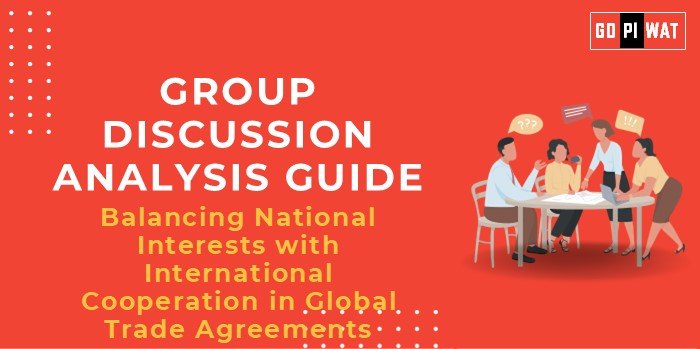📋 Group Discussion (GD) Analysis Guide: Balancing National Interests with International Cooperation in Global Trade Agreements
🌐 Introduction to the Topic
- Opening Context: Global trade agreements are pivotal in shaping the economic dynamics between nations, balancing national priorities with collaborative international growth. Their significance has surged as economic interdependence grows amidst geopolitical tensions.
- Topic Background: Originating post-WWII with GATT (General Agreement on Tariffs and Trade) and later evolving into the WTO framework, global trade agreements aim to reduce barriers, enhance trade, and ensure equitable economic development. Recent discussions center on their role in addressing modern challenges like climate change and digital trade.
📊 Quick Facts and Key Statistics
🌍 Global Trade Value: $32 trillion in 2023 – Demonstrates the extensive scale of international trade.
🌐 WTO Membership: 164 countries – Showcases the global commitment to multilateralism.
📉 Tariff Reduction: Average tariffs reduced from 22% (1947) to 5% (2023) – Indicates progress in trade liberalization.
⚖️ Trade-Related Disputes: Over 600 cases resolved by the WTO – Highlights the role of legal frameworks in maintaining order.
💹 Global GDP Contribution: Trade accounts for 61% of global GDP – Underscores its economic significance.
🌐 WTO Membership: 164 countries – Showcases the global commitment to multilateralism.
📉 Tariff Reduction: Average tariffs reduced from 22% (1947) to 5% (2023) – Indicates progress in trade liberalization.
⚖️ Trade-Related Disputes: Over 600 cases resolved by the WTO – Highlights the role of legal frameworks in maintaining order.
💹 Global GDP Contribution: Trade accounts for 61% of global GDP – Underscores its economic significance.
👥 Stakeholders and Their Roles
- 🏛️ Governments: Craft policies balancing national industries’ needs with compliance to trade agreements.
- 🌐 International Organizations: Bodies like WTO and UNCTAD mediate and provide frameworks for cooperation.
- 🏢 Private Sector: Corporations influence and adapt to trade rules, driving innovation and production.
- 🌱 Civil Society: Advocates for equitable practices, environmental considerations, and worker rights.
🏆 Achievements and Challenges
✨ Achievements
- 🌍 Economic Growth: Trade agreements foster global GDP growth by $4.2 trillion annually.
- 📈 Poverty Reduction: Helped lift 1 billion people out of poverty since 1990 through increased market access.
- ☮️ Conflict Reduction: Economic interdependence decreases the likelihood of conflicts between trading nations.
- 💡 Innovation Boost: Cross-border collaborations spur technological advancements.
⚠️ Challenges
- 📉 Inequality: Disproportionate benefits to developed nations exacerbate global inequities.
- ⚖️ Sovereignty Concerns: Critics argue agreements can limit domestic policy autonomy.
- 💰 Compliance Costs: Smaller economies often face high costs in aligning with trade requirements.
🌍 Global Comparisons: The EU exemplifies effective regional trade agreements, while African Continental Free Trade Area (AfCFTA) highlights ongoing struggles with implementation.
📢 Structured Arguments for Discussion
- ✅ Supporting Stance: “Global trade agreements catalyze economic growth and foster peaceful international relations.”
- ❌ Opposing Stance: “Such agreements often prioritize corporate interests over national sovereignty and local economies.”
- ⚖️ Balanced Perspective: “While trade agreements drive collaboration, equitable structures are essential to address disparities.”
🧠 Effective Discussion Approaches
- 🎯 Opening Approaches:
- Begin with a compelling statistic: “Global trade powers 61% of the world’s GDP, but its equitable distribution remains a challenge.”
- Pose a critical question: “Can international cooperation coexist with robust national policies?”
- 🤝 Counter-Argument Handling:
- Example: Use the US-China trade tensions to illustrate the interplay of national interests and global rules.
- Solution: Propose transparent mechanisms for resolving disputes.
📊 Strategic Analysis (SWOT)
- Strengths: Economic growth, peacebuilding, innovation exchange.
- Weaknesses: Compliance burdens, sovereignty erosion.
- Opportunities: Digital trade, green agreements.
- Threats: Protectionism, geopolitical conflicts.
🎓 Connecting with B-School Applications
- 💼 Real-World Applications: Explore trade policy impacts on industries or propose business strategies for leveraging trade agreements.
- 📚 Sample Interview Questions:
- “How do trade agreements impact the global supply chain?”
- “Discuss a case where a trade dispute reshaped a sector.”


